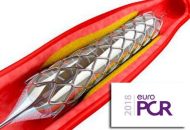The LEADERS FREE trial demonstrated that a polymer-free Biolimus A9-coated stent (BioFreedom™DCS; Biosensors Europe, Morges, Switzerland) is superior to a conventional stent (bare metal stent, BMS) in patients with high bleeding risk treated with only one month of dual antiplatelet therapy. Now, is this global study outcome applicable in cases of complex lesions with several…
EuroPCR 2018 | Ultimaster Registry: Difference in Strut Thickness
This work compared the safety and efficacy of angioplasty with thin-strut (80 µm) sirolimus-eluting stents with a cobalt chromium structure (Ultimaster) vs. thick-strut (120 µm) biolimus-eluting stents with a cobalt chromium structure (Nobori). This study compared two prospective multicenter single-arm registries: e-Ultimaster and NOBORI 2. The Ultimaster Registry included over 37,000 patients in 4 continents, while the NOBORI 2 Registry included…
EuroPCR 2018 | Consistent CTO Study: Rechanneling with Current Techniques and SYNERGY Stents
This observational study included 231 patients from 6 sites who presented chronic total occlusions and underwent rechanneling procedures using currently available techniques, which were successful in 90% of all cases (210 patients). All patients who underwent successful rechanneling received a SYNERGY stent and most of them underwent intravascular ultrasound (90.5%). There was only 1 patient lost to clinical follow-up…
EuroPCR 2018 | 2nd and 3rd-Generation DES for Bifurcation Lesions: Nothing New Under the Sun
This study aimed to assess the outcome of Culotte stenting with newer-generation drug-eluting stents (DES) in Medina 1, 1, 1 bifurcation lesions. The 2nd-generation device used was permanent-polymer everolimus-eluting stent Xience, a device for which there is comparatively plenty of evidence available. Alternatively, the 3rd-generation stent used was thin-strut abluminal bioresorbable-polymer everolimus-eluting stent SYNERGY. Patients with…
EuroPCR 2018 | SYNTAX II: Results at 2 Years for Best Angioplasty vs. Surgery in Multivessel Disease
Since the publication of the original SYNTAX trial, there have been great technical advancements that have influenced the results of angioplasty: New tools for risk stratification using the SYNTAX II score which integrate clinical and anatomical variables to the team’s decision-making process. Functional revascularization (hybrid use of fractional flow reserve or instantaneous wave-free ratio). Optimization of…
EuroPCR 2018 | DESSOLV III: Bioabsorbable vs. Durable Polymer at 2 Years
Most drug-eluting stents are coated by a polymer that is used to contain the antiproliferative drug. Once the drug is released, the polymer remains in place and its presence has been associated with inflammation, restenosis, and neoatherosclerosis. The MiStent device features a polymer that becomes bioabsorbable once the drug has been released, which could, theoretically,…
EuroPCR 2018 | LEADERS FREE: Complex Angioplasty in Patients with High Risk for Bleeding
The LEADERS FREE study showed that a biolimus A9-coated polymer-free stent was superior to a conventional stent in terms of safety and efficacy in patients who received dual antiplatelet therapy for only a month due to their high risk for bleeding. In this substudy, researchers analyzed 667 patients enrolled in the original LEADERS FREE trial who met certain requirements…
EuroPCR 2018 | Swedish Registry on the SYNERGY DES: tested in primary PCI for the first time
The study included 36292 consecutive patients undergoing acute myocardial infarction receiving PCI with the new generation stent SYNERGY (thin struts, bioresorbable polymer and everolimus eluting); 39.7% presented ST elevation MI. Kaplan-Meier curves at 2 years of patients receiving the SYNERGY vs patients receiving other drug eluting stents resulted very similar for thrombosis (0,69% vs 0,81%,…
EuroPCR 2018 | BIO-RESORT: Polymer vs. Bioresorbable Polymer; Have We Reached a Plateau with DES?
This study randomized 3514 patients to a thin-strut biodegradable polymer everolimus-eluting stent (SYNERGY) vs. a sirolimus-eluting stent (ORSIRO) vs. a durable polymer zotarolimus-eluting stent (RESOLUTE INTEGRITY). The combined endpoint, the rate of target vessel failure, was similar for all three devices (8.3% for the zotarolimos-eluting stent, 6.8% for the everolimus-eluting stent, and 6.6% for the sirolimus-eluting…
Post DES Dual Antiplatelet Therapy Still under Debate
The NIPPON trial (Nobori Dual Antiplatelet Therapy as Appropriate Duration) was a randomized study comparing a short dual antiplatelet therapy scheme (6 months) vs. a prolonged scheme (18 months) in patients receiving the Nobori drug eluting stent (Terumo, Tokyo, Japan) with a biodegradable abluminal polymer. It included 3,773 patients with chronic stable angina or acute coronary…









